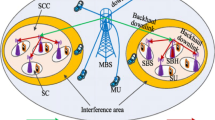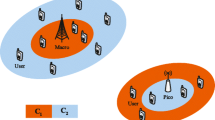Abstract
This paper investigates the energy-efficient radio resource allocation problem of the uplink smallcell networks. Different from the existing literatures which focus on improving the energy efficiency (EE) or providing fairness measured by data rates, this paper aims to provide fairness guarantee in terms of EE and achieve EE-based proportional fairness among all users in smallcell networks. Specifically, EE-based global proportional fairness utility optimization problem is formulated, taking into account each user’s quality of service, and the cross-tier interference limitation to ensure the macrocell transmission. Instead of dealing with the problem in forms of sum of logarithms directly, the problem is transformed into a form of sum of ratios firstly. Then, a two-step scheme which solves the subchannel and power allocation separately is adopted, and the corresponding subchannel allocation algorithm and power allocation algorithm are devised, respectively. The subchannel allocation algorithm is heuristic, but can achieve close-to-optimal performance with much lower complexity. The power allocation scheme is optimal, and is derived based on a novel method which can solve the sum of ratios problems efficiently. Numerical results verify the effectiveness of the proposed algorithms, especially the capability of EE fairness provisioning. Specifically, it is suggested that the proposed algorithms can improve the fairness level among smallcell users by 150–400 % compared to the existing algorithms.







Similar content being viewed by others
References
Boyd, S., & Vandenberghe, L. (2004). Convex Optimization. New York, NY: Cambridge University Press.
Bu, S., Yu, F., & Yanikomeroglu, H. (2015). Interference-aware energy-efficient resource allocation for OFDMA-based heterogeneous networks with incomplete channel state information. IEEE Transactions on Vehicular Technology, 64(3), 1036–1050. doi:10.1109/TVT.2014.2325823.
Buzzi, S., Colavolpe, G., Saturnino, D., & Zappone, A. (2012). Potential games for energy-efficient power control and subcarrier allocation in uplink multicell OFDMA systems. IEEE Journal of Selected Topics in Signal Processing, 6(2), 89–103. doi:10.1109/JSTSP.2011.2177069.
Dinkelbach, W. (1967). On nonlinear fractional programming. Management Science, 13(7), 492–498.
Ha, V. N., & Le, L. B. (2014). Fair resource allocation for OFDMA femtocell networks with macrocell protection. IEEE transactions on vehicular technology, 63(3), 1388–1401. doi:10.1109/TVT.2013.2284572.
Ho, C. Y., & Huang, C. Y. (2012). Non-cooperative multi-cell resource allocation and modulation adaptation for maximizing energy efficiency in uplink OFDMA cellular networks. IEEE Wireless Communications Letters, 1(5), 420–423. doi:10.1109/WCL.2012.061212.120239.
Jain, R., Chiu, D. M., & Hawe, W. R. (1984). A quantitative measure of fairness and discrimination for resource allocation in shared computer system (Vol. 38). Hudson, MA: Eastern Research Laboratory, Digital Equipment Corporation.
Jiang, C., Zhang, H., Ren, Y., & Chen, H. H. (2014). Energy-efficient non-cooperative cognitive radio networks: Micro, meso, and macro views. IEEE Communications Magazine, 52(7), 14–20. doi:10.1109/MCOM.2014.6852078.
Jong, Y. (2012). An efficient global optimization algorithm for nonlinear sum-of-ratios problem. www.optimizationonline.org.
Kelley, C. T. (2003). Solving nonlinear equations with Newton’s method (Vol. 1). Philadelphia: SIAM.
Kelly, F. P., Maulloo, A. K., & Tan, D. K. (1998). Rate control for communication networks: Shadow prices, proportional fairness and stability. Journal of the Operational Research Society, 49, 237–252.
Li, Y., Sheng, M., Tan, C. W., Zhang, Y., Sun, Y., Wang, X., et al. (2015). Energy-efficient subcarrier assignment and power allocation in OFDMA systems with max–min fairness guarantees. IEEE Transactions on Communications, 63(9), 3183–3195. doi:10.1109/TCOMM.2015.2450724.
Lu, Z., Bansal, T., & Sinha, P. (2013). Achieving user-level fairness in open-access femtocell-based architecture. IEEE Transactions on Mobile Computing, 12(10), 1943–1954. doi:10.1109/TMC.2012.157.
Miao, G., Himayat, N., Li, G., & Talwar, S. (2012). Low-complexity energy-efficient scheduling for uplink OFDMA. IEEE Transactions on Communications, 60(1), 112–120. doi:10.1109/TCOMM.2011.112811.090122.
Nguyen, T. D., & Han, Y. (2006). A proportional fairness algorithm with QoS provision in downlink OFDMA systems. IEEE Communications Letters, 10(11), 760–762. doi:10.1109/LCOMM.2006.060750.
Sabagh, M. R., Dianati, M., Tafazolli, R., & Mehrjoo, M. (2015). Energy efficient and quality of service aware resource block allocation in OFDMA systems. IET Communications, 9(12), 1479–1492. doi:10.1049/iet-com.2014.0782.
Shen, Z., Andrews, J., & Evans, B. (2005). Adaptive resource allocation in multiuser OFDM systems with proportional rate constraints. IEEE Transactions on Wireless Communications, 4(6), 2726–2737. doi:10.1109/TWC.2005.858010.
Wu, Q., Chen, W., Tao, M., Li, J., Tang, H., & Wu, J. (2015). Resource allocation for joint transmitter and receiver energy efficiency maximization in downlink OFDMA systems. IEEE Transactions on Communications, 63(2), 416–430. doi:10.1109/TCOMM.2014.2385705.
Xiong, C., Li, G., Zhang, S., Chen, Y., & Xu, S. (2012). Energy-efficient resource allocation in OFDMA networks. IEEE Transactions on Communications, 60(12), 3767–3778. doi:10.1109/TCOMM.2012.082812.110639.
Xiong, C., Lu, L., & Li, G. (2013). Energy-efficient spectrum access in cognitive radio. In IEEE PIMRC’13 (pp. 2528–2532). doi:10.1109/PIMRC.2013.6666572.
Xu, L., Yu, G., & Jiang, Y. (2015). Energy-efficient resource allocation in single-cell OFDMA systems: Multi-objective approach. IEEE Transactions on Wireless Communications, 14(10), 5848–5858. doi:10.1109/TWC.2015.2443104.
Xu, Q., Li, X., Ji, H., & Du, X. (2014). Energy-efficient resource allocation for heterogeneous services in OFDMA downlink networks: Systematic perspective. IEEE Transactions on Vehicular Technology, 63(5), 2071–2082. doi:10.1109/TVT.2014.2312288.
Ye, H., Lim, G., Cimini, L.J., & Tan, Z. (2013). Energy-efficient resource allocation in uplink OFDMA systems under QoS constraints. In IEEE Milcom’13 (pp. 424–428). doi:10.1109/MILCOM.2013.79.
Ye, H., Lim, G., Cimini, L. J., & Tan, Z. (2015). Energy-efficient scheduling and resource allocation in uplink OFDMA systems. IEEE Communications Letters, 19(3), 439–442. doi:10.1109/LCOMM.2015.2388487.
Zhang, H., Chu, X., Zheng, W., & Wen, X. (2012). Interference-aware resource allocation in co-channel deployment of OFDMA femtocells. In IEEE ICC’12 (pp. 4663–4667). doi:10.1109/ICC.2012.6364435.
Zhang, H., Jiang, C., Beaulieu, N., Chu, X., Wang, X., & Quek, T. (2015). Resource allocation for cognitive small cell networks: A cooperative bargaining game theoretic approach. IEEE Transactions on Wireless Communications, 14(6), 3481–3493. doi:10.1109/TWC.2015.2407355.
Zhang, H., Jiang, C., Beaulieu, N., Chu, X., Wen, X., & Tao, M. (2014). Resource allocation in spectrum-sharing OFDMA femtocells with heterogeneous services. IEEE Transactions on Communications, 62(7), 2366–2377. doi:10.1109/TCOMM.2014.2328574.
Zhang, H., Jiang, C., Mao, X., & Chen, H. H. (2016). Interference-limited resource optimization in cognitive femtocells with fairness and imperfect spectrum sensing. IEEE Transactions on Vehicular Technology, 65(3), 1761–1771. doi:10.1109/TVT.2015.2405538.
Zhang, H., Nie, Y., Cheng, J., Leung, V.C.M., & Nallanathan, A. (2015). Hybrid spectrum sensing based power control for energy efficient cognitive small cell network. In 2015 IEEE global communications conference (GLOBECOM) (pp. 1–5). doi:10.1109/GLOCOM.2015.7417809.
Zhou, L., Zhu, C., Ruby, R., Wang, X., Ji, X., Wang, S., et al. (2015). QoS-aware energy-efficient resource allocation in ofdm-based heterogenous cellular networks. International Journal of Communication Systems,. doi:10.1002/dac.2931.
Acknowledgments
This work was supported by the National Natural Science Foundation of China (61271179).
Author information
Authors and Affiliations
Corresponding author
Appendix: Proof of Theorem 2
Appendix: Proof of Theorem 2
Note that the Lagrangian dual function (17) can be decomposed into a \(M \times K\times N\) subfunctions, i.e.,
where \(L_{m,k}^n\left( {p_{m,k}^n,{\varvec{\lambda ,\gamma ,\zeta }}} \right) = \left( {{\mu _{m,k}}{w_{m,k}} + {\lambda _{m,k}}} \right) x_{m,k}^nr_{m,k}^n - \left( {{\mu _{m,k}}{\beta _{m,k}}\xi + {\gamma _{m,k}} + {\zeta _n}g_{M,m,k}^n} \right) x_{m,k}^np_{m,k}^n.\)
Due to that problem (13) is a convex optimization problem, the Karush-Kuhn-Tucker (KKT) conditions, i.e.,
are both the sufficient and necessary conditions which ensure certain power allocation solution \(p_{m,k}^n\) to be optimal [1]. Based on Eq. (33) of KKT conditions, i.e.,
we can derive the optimal power allocation as
where \({\left( y \right) ^ + } = \max \left( {0,y} \right)\) and \(WF_{m,k}^n = \frac{{\left( {{\mu _{m,k}}{w_{m,k}} + {\lambda _{m,k}}} \right) B}}{{\ln 2({\mu _{m,k}}{\beta _{m,k}}\xi + {\gamma _{m,k}} + {\zeta _n}g_{M,m,k}^n)}}.\)
Rights and permissions
About this article
Cite this article
Jing, W., Wen, X., Lu, Z. et al. Proportional-fair energy-efficient radio resource allocation for OFDMA smallcell networks. Wireless Netw 24, 695–707 (2018). https://doi.org/10.1007/s11276-016-1359-z
Published:
Issue Date:
DOI: https://doi.org/10.1007/s11276-016-1359-z




